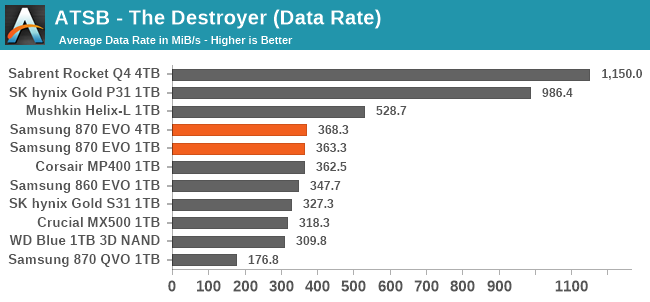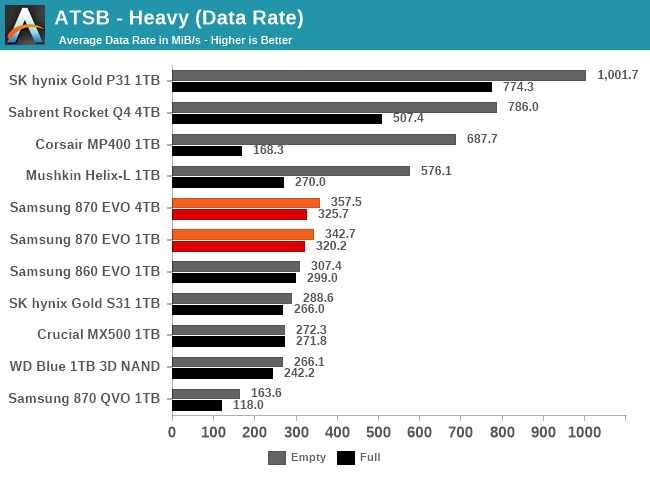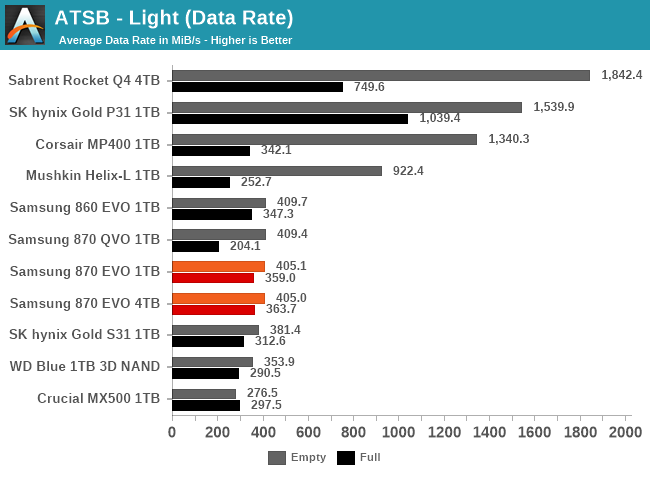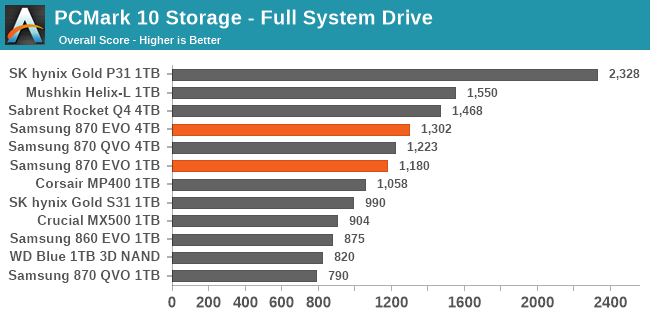The Samsung 870 EVO (1TB & 4TB) Review: Does the World Need Premium SATA SSDs?
by Billy Tallis on February 17, 2021 8:00 AM ESTAnandTech Storage Bench - The Destroyer
Our AnandTech Storage Bench tests are traces (recordings) of real-world IO patterns that are replayed onto the drives under test. The Destroyer is the longest and most difficult phase of our consumer SSD test suite. For more details, please see the overview of our 2021 Consumer SSD Benchmark Suite.
 |
|||||||||
| Average Data Rate | |||||||||
| Average Latency | Average Read Latency | Average Write Latency | |||||||
| 99th Percentile Latency | 99th Percentile Read Latency | 99th Percentile Write Latency | |||||||
| Energy Usage | |||||||||
For SATA drives, the Samsung 870 EVOs turn in class-leading scores on almost all of the performance metrics. But these improvements are all marginal at best; the SATA interface bottleneck almost completely levels the playing field. The small improvements to read latency brought by the 870 EVO pale in comparison to what is achieved by even entry-level NVMe SSDs.
In stark contrast to the performance numbers, the 870 EVOs turn out to be the most power-hungry TLC drives in this bunch: they sacrifice some of the efficiency improvements the 860 EVO provided, even though drives like the SK hynix Gold S31 have been able to deliver significant improvement on this.
AnandTech Storage Bench - Heavy
The ATSB Heavy test is much shorter overall than The Destroyer, but is still fairly write-intensive. We run this test twice: first on a mostly-empty drive, and again on a completely full drive to show the worst-case performance.
 |
|||||||||
| Average Data Rate | |||||||||
| Average Latency | Average Read Latency | Average Write Latency | |||||||
| 99th Percentile Latency | 99th Percentile Read Latency | 99th Percentile Write Latency | |||||||
| Energy Usage | |||||||||
The scores for the Heavy test paint much the same picture as for The Destroyer. The full-drive test runs additionally show that the worst-case performance of the mainstream SATA SSDs is still superior to many entry-level NVMe SSDs, even though the NVMe SSDs significantly outperform SATA for any more normal workload.
AnandTech Storage Bench - Light
The ATSB Light test represents ordinary everyday usage that doesn't put much strain on a SSD. Low queue depths, short bursts of IO and a short overall test duration mean this should be easy for any SSD. But running it a second time on a full drive shows how even storage-light workloads can be affected by SSD performance degradation.
 |
|||||||||
| Average Data Rate | |||||||||
| Average Latency | Average Read Latency | Average Write Latency | |||||||
| 99th Percentile Latency | 99th Percentile Read Latency | 99th Percentile Write Latency | |||||||
| Energy Usage | |||||||||
On the Light test, the measurable but imperceptible performance advantages of the 870 EVOs over other SATA drives have basically disappeared. The read latency scores on the full-drive test runs may be a tiny bit better than the 860 EVO, but the only scores that have clearly shifted with this new generation are the energy consumption figures that have creeped up.
PCMark 10 Storage Benchmarks
The PCMark 10 Storage benchmarks are IO trace based tests similar to our own ATSB tests. For more details, please see the overview of our 2021 Consumer SSD Benchmark Suite.
 |
|||||||||
| Full System Drive | Overall Score | Average Bandwidth | Average Latency | ||||||
| Quick System Drive | Overall Score | Average Bandwidth | Average Latency | ||||||
| Data Drive | Overall Score | Average Bandwidth | Average Latency | ||||||
The Full System Drive test from the PCMark 10 Storage suite shows a much wider spread of performance scores among SATA drives than our ATSB traces, but also a much smaller advantage for the NVMe drives. Judging by this test, the 870 EVO offers a small but real improvement to performance compared to earlier SATA drives. The 4TB 870 QVO also scores quite well since it benefits from the same controller and has enough SLC cache to almost match the performance of the 4TB 870 EVO.
The subset of tests included in the Quick System Drive and Data Drive benchmarks show a more level playing field among SATA SSDs, and a greater advantage for NVMe drives. Since we run these tests before the Full System Drive test, each drive is closer to its fresh out-of-the-box state, which helps these tests get closer to showing the theoretical peak performance of a drive.










136 Comments
View All Comments
Marlin1975 - Wednesday, February 17, 2021 - link
So with high capacity SSD becoming more common and cheaper is there any movement to update the SATA standard to take advantage?Seems hard drive makers would be trying to get this to happen. Even a small performance boost would sell larger capacity SSDs.
ckmac - Wednesday, February 17, 2021 - link
Nope. Back in 2013-14, there was a new standard named "SATA Express", but it never gained any traction in the marketplace. That's why SSDs have moved to the M.2 form factor, with the PCIe interface. There's much more bandwidth:PCIe 3.0 x4 = 3.938 GB/s = 31.5 Gbps
PCIe 4.0 x4 = 7.877 GB/s = 63.0 Gbps
The same form factor can be used in laptops, desktops, consoles, etc. Newer motherboards have 2 to 3 total M.2 slots.
SarahKerrigan - Wednesday, February 17, 2021 - link
I have a SATA Express laptop! The complete lack of drives for the form factor aside from the one it shipped with (an OEM-specific Toshiba XG3 iirc) is somewhat annoying - but luckily there's an M.2 adapter available in a pinch.DanNeely - Wednesday, February 17, 2021 - link
Sata Express isn't even really an update of SATA. They just added the ability to run 2 PCIe lanes instead of a SATA link down the cable; effectively making it equivalent to a low end m.2 drive.Kamen Rider Blade - Wednesday, February 17, 2021 - link
The issue with the M.2 connector is that it wasn't designed for "Hot Swap"and the designed in Insertion life isn't high compared to the SATA style connector
- M.2 = ____ 50 Cycles
- SATA = 10,000 Cycles
Murloc - Wednesday, February 17, 2021 - link
even hobby builders who upgrade their components often are likely to touch that maybe once every year at most. And the motherboard is unlikely to last more than 5 years if they're that upgrade-crazy.mr_tawan - Thursday, February 18, 2021 - link
well what about M.2 replace SD standard ? Maybe it can becomes pro-level video camera storage. Having 50 cycles of hot swap seems to be mis-opportunity.dotjaz - Friday, February 19, 2021 - link
why would they need that? Why are you creating problem when it's not there?M.2 can't hotswap at all. It's physically too big. You'll need to completely redesign the physical and protocol layer. Why wouldn't you just use SD Express?
MetaCube - Thursday, March 18, 2021 - link
WtfCaedenV - Wednesday, February 17, 2021 - link
I mean... with SATA drives/cables, then you need to unhook and reattach them all the time because the wires get in the way. m.2 is just on the mobo, so you don't need to ever mess with it unless the mobo is being replaced, or you are upgrading.